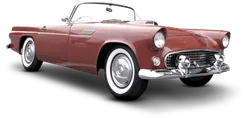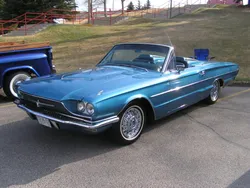

Ford Thunderbird - Generation 4 Facelift 1965 Overview
Explore the Ford Thunderbird, focusing on the iconic Generation 4 facelift from 1965. Discover its distinctive features and historical significance in the automotive world.
The Ford Thunderbird has been an iconic name in the automotive world since its introduction in 1955, and its fourth generation, produced from 1964 to 1966, marked a significant evolution in both des...
History and Features
Mycarro AI
Apr 26, 2025
The Ford Thunderbird has been an iconic name in the automotive world since its introduction in 1955, and its fourth generation, produced from 1964 to 1966, marked a significant evolution in both design and engineering. The 1965 facelift of the fourth-generation Thunderbird introduced various aesthetic changes and technological advancements that would solidify its status as a luxurious personal vehicle during the era.
Design Changes
The most noticeable changes to the Thunderbird came in the form of design updates. The 1965 facelift featured a more aggressive front end, with a revised grille that was deeper and bore a more pronounced Thunderbird emblem. The front bumpers were also redesigned, flowing seamlessly into the car's fenders, which provided a more modern and sleek look. Furthermore, the rear taillights were altered to a more streamlined design, incorporating stylish vertical elements that enhanced the car's profile. These changes gave the Thunderbird a more sophisticated and aerodynamic appearance while maintaining its distinct character.
Interior Comfort
The fourth-generation Thunderbird was well-known for its commitment to comfort and luxury, and the 1965 facelift enhanced this aspect even further. The cabin was spacious, designed to accommodate four passengers comfortably, with plush seating upholstered in high-quality materials. The dashboard featured an elegant layout, filled with stylish instrumentation that was both functional and alluring. For 1965, the Thunderbird came equipped with new features such as an optional AM/FM radio, electric windows, and a six-way power seat, which contributed to an overall experience of opulence and convenience. Ford also emphasized sound insulation, which helped in creating a quieter ride, allowing passengers to enjoy the luxury of their surroundings.
Performance and Engineering
Under the hood, the 1965 Ford Thunderbird remained consistent with previous models, offering a choice of powerful V8 engines. The standard 390 cubic inch V8 engine produced 300 horsepower, providing plenty of power for both city and highway driving. An optional 427 cubic inch engine was also available, raising the power output to 335 horsepower. This level of performance ensured that the Thunderbird was not only a comfortable cruiser but also represented Ford's engineering prowess and commitment to providing a thrilling driving experience.
Technology Advancements
The 1965 model year introduced several important technological advancements that improved the overall driving experience. One notable addition was the Ford-built automatic transmission that offered better efficiency and smoother gear changes. The car also featured power-assisted brakes, which enhanced stopping capabilities and provided drivers with greater confidence on the road. Additionally, the inclusion of optional front disc brakes marked a significant leap forward in braking technology, ensuring better safety and control compared to drum brakes used in earlier models.
Market Position and Reception
The Ford Thunderbird was targeted towards affluent consumers who were seeking a stylish and powerful personal luxury coupe. Its competition included notable names like the Chevrolet Corvette and the Chrysler Newport. The 1965 facelift earned positive reviews from both consumers and automotive critics. It was appreciated for its bold styling, luxury features, and robust performance. Enthusiasts of the era admired the Thunderbird for representing the American spirit of freedom and indulgence. The fourth-generation Thunderbird became a symbol of success and sophistication, making it an instant classic.
Legacy and Conclusion
As the fourth generation of the Ford Thunderbird came to an end in 1966, it left behind a significant legacy in the automotive landscape. The 1965 facelift represented a pivotal moment that solidified the Thunderbird's position as a cultural icon in America. Today, classic car enthusiasts continue to cherish the 1965 Thunderbird for its unique blend of style, comfort, and performance. In both its era and today, the Thunderbird epitomizes the enduring appeal of American muscle and luxury cars, a true reflection of an age defined by innovation and style on the open roads.
